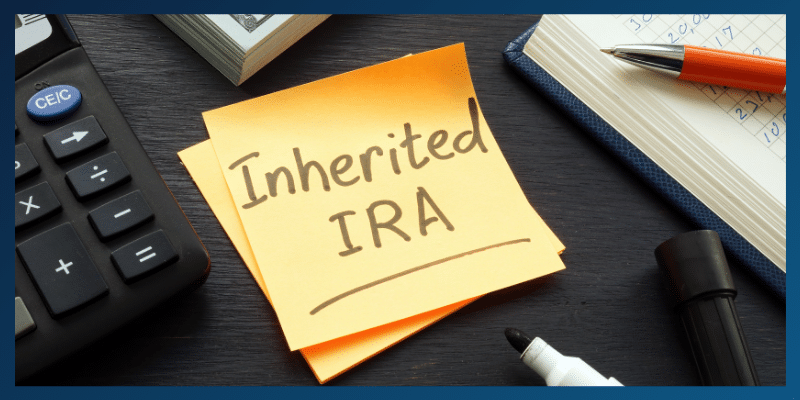
There have recently been some discussions around important, but obscure, rules of the SECURE 2.0 Act. While these rules will likely apply in a small minority of cases, the results could have a major impact on your retirement or investment planning.
In this article, we delve into three lesser-discussed provisions of the SECURE 2.0 Act that can significantly impact your retirement planning. By the end of this read, you’ll have a clearer understanding of how these provisions can shape your financial future, and why seeking the guidance of a trusted wealth advisor is more crucial than ever.
Three Hidden SECURE Act 2.0 Rules
RMDs for Annuities
The SECURE 2.0 Act brings a significant change for those subject to Required Minimum Distributions (RMDs) with annuities in their IRAs. When an IRA annuity has been annuitized, the RMD is computed differently than RMDs for other non-annuitized IRA accounts you own. For the non-annuitized IRAs, you divide the prior year’s account balance by your life expectancy factor. But for the annuitized IRA, the annuity payments you receive during a year are considered the RMD for that year.
Typically, this annual amount is larger than the RMD that would be required if the annuitized IRA was determined under the non-annuitized RMD method. However, under the rule in effect before SECURE 2.0, you couldn’t credit this overage against the RMD for the non-annuitized IRA accounts. In other words, you had two separate RMDs – one for the annuitized IRA and one for the non-annuitized IRA.
Starting in 2023, you can combine the value of both annuitized and non-annuitized IRA accounts and calculate your total RMD based on your life expectancy. Then, subtract the annual annuity payments from the total RMD. This change can result in significantly reduced RMDs.
Example: Amy (age 73 in 2023) purchased an annuity with $250,000 of her funds in IRA #1 that will start paying her a monthly benefit of $1,250. As of 12/31/22, Amy also has $200,000 in IRA #2 which is invested in mutual funds. For 2023, Amy will receive $15,000 ($1,250 x 12) of annuity payments that will satisfy her RMDs from IRA #1. If the value of Amy’s annuity as of 12/31/22 was $250,000, under the new rule her total 2023 RMD would be $16,981.13 ($250,000 + $200,000)/26.5. $15,000 of that total RMD would be satisfied by the IRA #1 annuity payments, requiring Amy to take only $1,981.13 from IRA #2. This is about $5,500 less than under the old rule.
However, a challenge remains: obtaining a proper valuation of the annuity, which SECURE 2.0 doesn’t specify. Until IRS guidance is available, taking advantage of this rule might be tricky.
Section 327 Election for IRA Spousal Beneficiaries
Starting in 2024, Section 327 of SECURE 2.0 introduces new options for spousal beneficiaries. Surviving spouses can elect to:
- Delay RMDs until the deceased spouse’s RMD age.
- Calculate RMDs using the Uniform Lifetime Table.
- If the surviving spouse dies before RMDs begin, the surviving spouse’s beneficiaries will be treated as though they were the original beneficiaries of the account (which would allow any EDBs to stretch distributions over their life expectancy instead of being stuck with the 10-year Rule that would otherwise apply).
While regulations will be needed to clarify the details of this new option, it would appear that this benefits surviving spouses inheriting from younger spouses, allowing them to delay and reduce RMDs.
Example: John (age 50) owns an IRA and is married to Mary (age 60). Mary is the beneficiary. John dies in 2023 and Mary makes a Section 327 election. Mary will be treated as if she were age 50 and will not have to begin RMDs until John has reached age 75 (the year 2048)!
Nonfungible Tokens (NFTs)
A recent trend has been for investors to use Nonfungible Tokens (NFTs) in IRA accounts and although the rise of NFTs presents an intriguing investment avenue, it comes with IRS regulations. An NFT is a unique digital identifier that is recorded using distributed ledger technology and may be used to certify the authenticity and ownership of an associated right or asset. NFTs can be traded and exchanged for money, cryptocurrencies, or other NFTs.
In March, the IRS issued Notice 2023-27, which provides guidance on when an NFT is deemed to be a “collectible.” Current law provides that the acquisition by an IRA of a collectible shall be treated as a distribution from the IRA equal to the cost to the IRA of the collectible. Collectibles include:
- Any work of art
- Any rug or antique
- Any metal or gem
- Any stamp or coin
- Any alcoholic beverage
- Any other tangible personal property specified by the IRS
Not all NFTs in IRAs will trigger a deemed distribution. Certain coins (gold, silver, or platinum) and bullion are excluded from this definition. Collectibles include various items, and while some NFTs may not fall into this category, advisors should carefully assess NFTs within IRAs to avoid unexpected tax consequences.
Example: Joe, 45, invested $200,000 of his IRA funds in an NFT when it was popular. The NFT is linked to ownership rights to a collectible. But now the NFT turns out to be worthless. Joe will still owe tax on the full $200,000 (plus a 10% penalty), even though it’s worth nothing!

Mission Wealth Can Help You Retire with Confidence
This may be your first time retiring, but it's not ours. Careful coordination is required to ensure your retirement income strategy is tax-efficient and sustainable. You will face many decisions when retiring. Let us guide you through your options and create a plan.
Mission Wealth’s vision is to provide caring advice that empowers families to achieve their life dreams. Our founders were pioneers in the industry when they embraced the client-first principles of objective advice, comprehensive financial planning, coordination with other professional advisors, and proactive service. We are fiduciaries, and our holistic planning process provides clarity and confidence. For more information on Mission Wealth, please visit missionwealth.com.
To schedule a complimentary meeting with a Mission Wealth financial advisor, contact us today at (805) 882-2360.
Mission Wealth is a Registered Investment Advisor. This commentary reflects the personal opinions, viewpoints, and analyses of the Mission Wealth employees providing such comments. It should not be regarded as a description of advisory services provided by Mission Wealth or performance returns of any Mission Wealth client. The views reflected in the commentary are subject to change at any time without notice. Nothing in this commentary constitutes investment advice, performance data, or any recommendation that any particular security, portfolio of securities, transaction, or investment strategy is suitable for any specific person. Any mention of a particular security and related performance data is not a recommendation to buy or sell that security. Mission Wealth manages its clients’ accounts using a variety of investment techniques and strategies, which are not necessarily discussed in the commentary. Investments in securities involve the risk of loss. Past performance is no guarantee of future results.
Let's Keep in Touch!
Subscribe for exclusive content and timely tips to empower you on your financial journey. Our communications go straight into your inbox, so you'll never miss out on expert advice that can positively impact your life.Recent Retirement Articles

6 Financial Steps to Take if You’ve Been Impacted by a Corporate Layoff
September 4, 2025
Holding On to These Moments: Allyn’s Retirement Story
August 27, 2025


